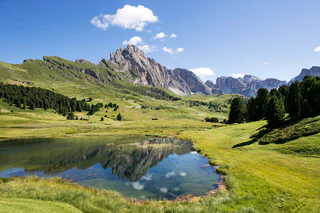
1/6
Viewpoint Lech Sant
S.Cristina Gherdëina/S.Cristina Val Gardena/S.Cristina Gherdëina/St.Christina in Gröden, S.Crestina Gherdëina/Santa Cristina Val Gardana, Dolomites Region Val Gardena
Jižní Tyrolsko je obzvláště bohaté na příběhy, které se vinou kolem tajných míst a neobvyklých přírodních útvarů. Památky, jako jsou čarodějnické lavice na Alpe di Siusi/Seiser Alm, vyprávějí příběhy o čarodějnicích a králích, zatímco místa síly, jako je "Stoanerne Mandln" s více než stovkou cairnů nebo starobylé zříceniny na kopci Castelfeder, vybízejí návštěvníky k odpočinku a hlubokému nádechu. Jedinečné přírodní útvary, jako jsou zemní pyramidy, jsou místa, která stojí za procházku a prozkoumání.

1/6
S.Cristina Gherdëina/S.Cristina Val Gardena/S.Cristina Gherdëina/St.Christina in Gröden, S.Crestina Gherdëina/Santa Cristina Val Gardana, Dolomites Region Val Gardena

Dobbiaco Nuova/Neutoblach, Toblach/Dobbiaco, Dolomites Region 3 Zinnen

Bolzano Centro/Bozen Zentrum, Bolzano/Bozen, Bolzano/Bozen and environs

1/3
Gomagoi/Gomagoi, Stilfs/Stelvio, Vinschgau/Val Venosta

Dobbiaco Nuova/Neutoblach, Toblach/Dobbiaco, Dolomites Region 3 Zinnen

Sexten/Sesto, Dolomites Region 3 Zinnen

1/3
Aldino/Aldein, Aldein/Aldino

1/2
Plata/Platt, Moos in Passeier/Moso in Passiria, Meran/Merano and environs

1/3
Brunico città/Bruneck Stadt, Bruneck/Brunico, Dolomites Region Kronplatz/Plan de Corones

1/4
Salorno/Salurn, Alto Adige Wine Road

1/5
Colma/Kollmann, Barbian/Barbiano, Brixen/Bressanone and environs

1/8
Terento/Terenten, Terenten/Terento, Brixen/Bressanone and environs

1/3
Martello/Martell, Martell/Martello, Vinschgau/Val Venosta

Lutago/Luttach, Ahrntal/Valle Aurina, Ahrntal/Valle Aurina

Pavicolo/Pawigl, Lana, Meran/Merano and environs

Tesido/Taisten, Welsberg-Taisten/Monguelfo-Tesido

1/3
Sesto/Sexten, Sexten/Sesto, Dolomites Region 3 Zinnen

1/3
Dobbiaco Nuova/Neutoblach, Toblach/Dobbiaco, Dolomites Region 3 Zinnen

1/3
Sesto/Sexten, Sexten/Sesto, Dolomites Region 3 Zinnen

Bolzano Centro/Bozen Zentrum, Bolzano/Bozen, Bolzano/Bozen and environs

Bolzano Centro/Bozen Zentrum, Bolzano/Bozen, Bolzano/Bozen and environs

1/2
Rasa/Raas, Natz-Schabs/Naz-Sciaves, Brixen/Bressanone and environs

1/7
Ortisei/Urtijëi/St. Ulrich/Urtijëi, Urtijëi/Ortisei, Dolomites Region Val Gardena

1/4
Terento/Terenten, Terenten/Terento, Brixen/Bressanone and environs

Silandro/Schlanders, Schlanders/Silandro, Vinschgau/Val Venosta

Auna di Sotto/Unterinn, Ritten/Renon, Bolzano/Bozen and environs

1/4
Chiusa/Klausen, Klausen/Chiusa, Brixen/Bressanone and environs

1/3
Trafoi/Trafoi, Stilfs/Stelvio, Vinschgau/Val Venosta

1/4
Tartsch/Tarces, Mals/Malles, Vinschgau/Val Venosta

1/6
Soprabolzano/Oberbozen, Ritten/Renon, Bolzano/Bozen and environs